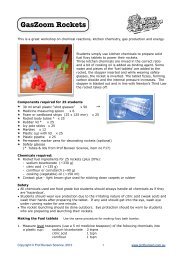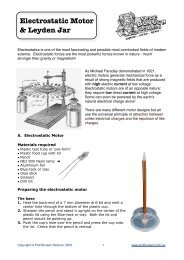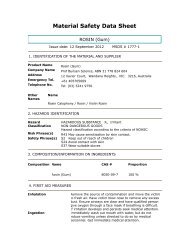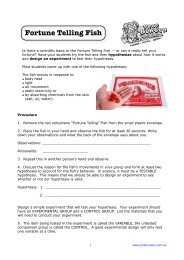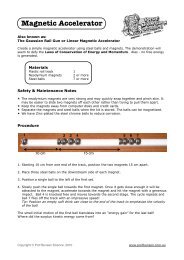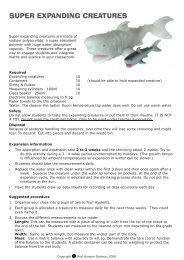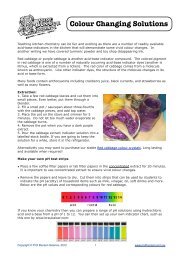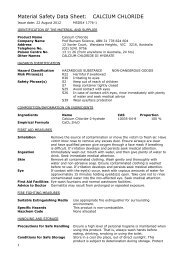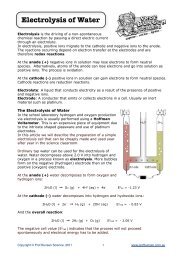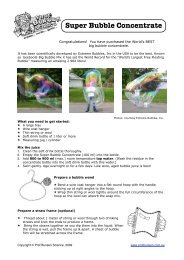Material Safety Data Sheet - Prof Bunsen
Material Safety Data Sheet - Prof Bunsen
Material Safety Data Sheet - Prof Bunsen
You also want an ePaper? Increase the reach of your titles
YUMPU automatically turns print PDFs into web optimized ePapers that Google loves.
<strong>Material</strong> <strong>Safety</strong> <strong>Data</strong> <strong>Sheet</strong><br />
Page 1 of 7 Issue date: April 2010<br />
ECOFOAM GP330 ISOCYANATE<br />
1. IDENTIFICATION OF THE MATERIAL AND SUPPLIER<br />
Product Name: ECOFOAM GP330 ISOCYANATE<br />
Synonym: None<br />
Use: Polyurethane Isocyanate<br />
Era Polymers Pty Ltd<br />
25-27 Green Street<br />
Banksmeadow NSW 2019<br />
Australia<br />
Ph: +61 2 9666 3788<br />
Fax: +61 2 9666 4805<br />
Emergency Advice All Hours:<br />
Technical Manager +61 2 9666 3788<br />
2. HAZARDS IDENTIFICATION<br />
HAZARDOUS ACCORDING TO NOHSC CRITERIA<br />
Hazard Category: Harmful (Xn), Irritant (Xi)<br />
Hazard Classification: HAZARDOUS SUBSTANCE, NON-DANGEROUS GOOD<br />
RISK PHRASES<br />
R20 Harmful by inhalation.<br />
R36/37/38 Irritating to eyes, respiratory system and skin.<br />
R42/43 May cause sensitisation by inhalation and skin contact.<br />
SAFETY PHRASES<br />
S23 Do not breathe vapour/spray.<br />
S36/37 Wear suitable protective clothing and gloves.<br />
S45 In case of accident or if you feel unwell, contact a doctor immediately and show this container or label.<br />
Poison Schedule: S6 [Aust]<br />
This material is a Scheduled S6 Poison and must be stored, handled and used according to the appropriate regulations.<br />
Warning Statement:<br />
Avoid breathing vapours. Avoid skin and eye contact. Breathing of vapours may produce asthma-like symptoms. Skin<br />
contact may cause allergic reaction.<br />
3. COMPOSITION / INFORMATION ON INGREDIENTS<br />
SUBSTANCE NAME Proportion CAS Number<br />
DIPHENYLMETHANE DIISOCYANATE (Isomers and Homologues) [MDI] Greater than 60% 9016-87-9<br />
All other ingredients not hazardous according to NOHSC Criteria.<br />
4. FIRST AID MEASURES<br />
Swallowed:<br />
If swallowed, DO NOT induce vomiting. Seek medical attention immediately. Give nothing by mouth. Wash out the<br />
mouth with water (do not swallow). Never give fluids or induce vomiting if person is unconscious or is having<br />
convulsions.
<strong>Material</strong> <strong>Safety</strong> <strong>Data</strong> <strong>Sheet</strong><br />
Page 2 of 7 Issue date: April 2010<br />
ECOFOAM GP330 ISOCYANATE<br />
Eye:<br />
If material is splashed into eyes, immediately, flush with plenty of water for 15 minutes, ensuring eyelids are held open.<br />
Seek medical attention without delay, preferably from an ophthalmologist.<br />
Skin:<br />
If material is splashed onto the skin, remove any contaminated clothing and wash skin thoroughly with plenty of water<br />
and soap (warm water is preferable if available). Flush skin with water. Seek medical attention if irritation persists<br />
after washing. An MDI skin decontamination study demonstrated that cleaning very soon after exposure is important,<br />
and that a polyglycol-based skin cleanser or corn oil may be more effective than soap and water.<br />
Inhaled:<br />
Remove victim to fresh air. Apply resuscitation if victim is not breathing. If breathing is difficult, oxygen should be<br />
administered by a qualified person. Seek medical attention.<br />
First Aid Facilities:<br />
Eye wash fountain, safety shower and normal washroom facilities.<br />
Advice to Doctor:<br />
Treat symptomatically. May cause respiratory sensitisation or asthma-like symptoms. Bronchodilators, expectorants,<br />
and anti-tussives may be of help. Excessive exposure may aggravate pre-existing asthma and other respiratory<br />
disorders (e.g. emphysema, bronchitis, reactive airway dysfunction syndrome). Treat bronchospasm with inhaled beta2<br />
agonist and oral or parenteral corticosteroids. Respiratory symptoms, including pulmonary oedema, may be delayed.<br />
Persons receiving significant exposure should be observed for 24-48 hours for signs of respiratory distress. Maintain<br />
adequate ventilation and oxygenation of the patient. If you are sensitised to diisocyanates, consult your doctor<br />
regarding working with other respiratory irritants or sensitisers. Although cholinesterase depression has been reported<br />
with this material, it is not of benefit in determining exposure and need not be considered in the treatment of persons<br />
exposed to the material. Treatment of exposure should be directed at the control of symptoms and the clinical condition<br />
of the patient.<br />
In case of poisoning, contact Poisons Information Centre<br />
In Australia call Tel: 131126<br />
In New Zealand Tel: 034747000<br />
5. FIRE-FIGHTING MEASURES<br />
Fire/Explosion Hazard<br />
If safe to do so, move undamaged containers from fire area.<br />
HAZARDOUS DECOMPOSITION PRODUCTS: Decomposes on heating emitting toxic fumes including oxides of<br />
carbon and nitrogen, and hydrogen cyanide.<br />
OTHER FIRE/EXPLOSION HAZARDS: During a fire, smoke may contain the original material in addition to<br />
combustion products of varying composition which may be toxic and/or irritating. Contamination of isocyanates with<br />
water could lead to dangerous pressure inside closed containers by generation of carbon dioxide. Containers may burst<br />
if overheated. Do not discharge extinguishing waters into streams, rivers and lakes.<br />
FIRE FIGHTING PROCEDURES: Keep people away. Isolate fire area and deny unnecessary entry. Stay upwind.<br />
Keep out of low areas where gases (fumes) can accumulate. Fight fire from protected location or safe distance. Fire<br />
fighters to wear positive pressure Self-Contained Breathing Apparatus (SCBA) and full protective clothing (including<br />
helmet, coat trousers, boots and gloves).<br />
EXTINGUISHING MEDIA: Use carbon dioxide; dry chemical; protein-based foam; or alcohol-resistant foam. If water<br />
is to be used, it must be sprayed only in large quantities (see Section 10 - Stability and Reactivity).<br />
HAZCHEM CODE: None allocated [Aust]
<strong>Material</strong> <strong>Safety</strong> <strong>Data</strong> <strong>Sheet</strong><br />
Page 3 of 7 Issue date: April 2010<br />
ECOFOAM GP330 ISOCYANATE<br />
FLAMMABILITY<br />
This material is not flammable. This material is a C2 Combustible according to AS1940 - Storage and Handling of<br />
Flammable and Combustible Liquids.<br />
6. ACCIDENTAL RELEASE MEASURES<br />
PROTECT PEOPLE:<br />
Avoid any contact. Barricade area. Evacuate non-emergency personnel from area. Only trained and properly protected<br />
personnel should be involved in clean-up operations. Keep upwind of spill. Ventilate area. Use appropriate personal<br />
protective equipment (refer to Section 8 - Exposure Controls / Personal Protection). Respiratory protection should be<br />
worn, including positive pressure self-contained breathing apparatus.<br />
PROTECT THE ENVIRONMENT:<br />
Contain liquid to prevent contamination of soil, surface water or ground water. Prevent from entering, sewers or drains.<br />
Should the product enter sewer or drains, it should be pumped into a covered vented container, the cover should be<br />
placed loosely on the container, but not made pressure tight. Move container to a well-ventilated area. Emergency<br />
services may need to be called to assist in the clean-up operation.<br />
CLEAN-UP:<br />
Supplies of suitable decontaminant should always be kept available. Contain and cover the spillage with<br />
decontaminant, wet earth or wet sand and leave to react for at least 30 minutes. Collect material in suitable and<br />
properly labelled open-top containers and remove for further decontamination if necessary. DO NOT place in sealed<br />
container. Prolonged contact with water results in a chemical reaction, which may result in rupture of the container due<br />
to generation of carbon dioxide gas. Remove to a well ventilated area. Clean up floor areas. Wash area well with<br />
water. Test atmosphere for vapours to ensure safe working conditions before other personnel are allowed in the area.<br />
Suitable decontaminant solutions:<br />
Formulation 1 - sodium carbonate 5-10%; liquid detergent 0.2-2%; water to make up to 100%.<br />
Formulation 2 - concentrated ammonia solution 3-8%; liquid detergent 0.2-2%; water to make up to 100%.<br />
Note: If ammonia is used, use good ventilation to prevent vapour exposure.<br />
7. HANDLING AND STORAGE<br />
Avoid contact of this product with water at all times during handling and storage.<br />
HANDLING:<br />
Products based on diisocyanates should always be used in a well-ventilated area with appropriate local extraction in<br />
such a way that the exposure standards for these materials are not exceeded. It is recommended that the diisocyanate<br />
concentration in air be checked at regular intervals. Keep equipment clean. Use disposable containers and tools where<br />
possible. Do no eat, drink or smoke in the workplace.<br />
STORAGE:<br />
Store in a cool, dry place. Keep containers tightly closed when not in use. Protect from atmospheric moisture.<br />
Products based on diisocyanates react with water liberating carbon dioxide, which can lead to excessive pressure in<br />
closed containers, and form solid insoluble polymers, which can block pipes, valves, etc. Contact with copper or copper<br />
alloys and galvanised surfaces must be avoided, so valves etc made from these materials must not be used in equipment<br />
for storing and handling diisocyanates. It is recommended that stainless steel with an appropriate lining be used, to a<br />
minimum standard of Packing Group III. Do not store in open containers. Damaged or punctured drums should be<br />
emptied and disposed of properly.<br />
STORAGE REGULATIONS:<br />
C2 Combustible Liquid according to AS1940 - Storage and Handling of Flammable and Combustible Liquids. Store in<br />
accordance with regulations for storage of combustible liquids.
<strong>Material</strong> <strong>Safety</strong> <strong>Data</strong> <strong>Sheet</strong><br />
Page 4 of 7 Issue date: April 2010<br />
ECOFOAM GP330 ISOCYANATE<br />
8. EXPOSURE CONTROLS / PERSONAL PROTECTION<br />
Exposure Standards<br />
No exposure standards are available for this product, however, the following exposure standards have been assigned by<br />
[NOHSC] to the following components of the product:<br />
DIPHENYLMETHANE DIISOCYANATE (Isomers and Homologues) [MDI]<br />
(NOHSC Australia)<br />
Isocyanates, all (as -NCO)<br />
[TWA] 0.02 mg/m³<br />
[STEL] 0.07 mg/m³<br />
Notices: Sen<br />
Engineering Controls<br />
Engineering controls should be installed and regularly monitored to ensure exposure to vapour/aerosol is minimised.<br />
Exhaust systems should be designed in accordance with workplace conditions. The air should always be moved away<br />
from the source of vapour generation and the person working at this point. The odour and irritancy of this material are<br />
inadequate to warn of excessive exposure.<br />
Personal Protection Equipment<br />
CLOTHING: Wear suitable protective clothing to prevent skin contact - overalls, boots, and apron. Suitable materials<br />
include butyl rubber, neoprene, nitrile/butadiene rubber, laminated polyethylene.<br />
GLOVES: Wear chemical-resistant gloves to prevent skin contact. Examples of preferred glove barrier materials<br />
include: butyl rubber, chlorinated polyethylene, polyethylene, or ethyl vinyl alcohol laminate (EVAL). Examples of<br />
acceptable glove barrier materials include: natural rubber (latex), neoprene, nitrile/butadiene rubber (nitrile or NBR),<br />
polyvinyl chloride (PVC or vinyl), or viton.<br />
EYES: Wear safety glasses with side shields, chemical goggles or face shield to protect eyes.<br />
RESPIRATORY PROTECTION: Avoid breathing of vapours/gases. Atmospheric levels should be maintained below<br />
the exposure standard. When atmospheric levels may exceed the exposure standard, use an approved air-purifying<br />
respirator equipped with an organic vapour sorbent and a particulate filter. For situations where the atmospheric levels<br />
may exceed the level for which an air-purifying respirator is effective, use a positive pressure air-supplying respirator<br />
(airline or SCBA). For emergency response, or for situations where the atmospheric level is unknown, use an approved<br />
positive-pressure self-contained breathing apparatus or positive-pressure airline with auxiliary self-contained air supply.<br />
Select and use respirators in accordance with AS/NZS 1715/1716.<br />
9. PHYSICAL AND CHEMICAL PROPERTIES<br />
Appearance:<br />
Dark amber viscous liquid<br />
Boiling Point Melting Point: BP > 200°C (decomposes), MP = forms crystals below 10°C<br />
Vapour Pressure: 200°C (DIN 51758)<br />
Flammability Limits:<br />
Not applicable<br />
Solubility in Water:<br />
Insoluble in water, reacts with water liberating carbon dioxide<br />
Other Properties<br />
Vapour density = 8.5 (air = 1)<br />
10. STABILITY AND REACTIVITY<br />
STABILITY:<br />
Stable under normal conditions of use.<br />
HAZARDOUS DECOMPOSITION PRODUCTS:<br />
Emits toxic fumes including oxides of carbon and nitrogen, isocyanate vapours and hydrogen cyanide when heated to<br />
decomposition.
<strong>Material</strong> <strong>Safety</strong> <strong>Data</strong> <strong>Sheet</strong><br />
Page 5 of 7 Issue date: April 2010<br />
ECOFOAM GP330 ISOCYANATE<br />
HAZARDOUS POLYMERIZATION:<br />
Can occur. Polymerisation can be catalysed by strong bases and water. Can react with itself at temperatures above<br />
160°C. Products based on diisocyanates react with many materials such as bases, ammonia, 1° and 2° amines, alcohols,<br />
water and acids generating heat. The reaction becomes progressively more vigorous and can be violent at higher<br />
temperatures if the miscibility of reaction partners is good, or is supported by stirring or the presence of solvents.<br />
Products based on diisocyanates are insoluble in, and denser than, water and sink to the bottom, but react slowly at the<br />
interface. A solid water-insoluble layer of polyurea is formed and carbon dioxide gas is liberated.<br />
INCOMPATIBILITIES:<br />
Acids, alcohols, amines, bases, strong oxidising agents, water, galvanised metals, and copper and its alloys.<br />
CONDITIONS TO AVOID:<br />
Excessive heat, ignition sources and incompatible materials.<br />
11. TOXICOLOGICAL INFORMATION<br />
No adverse health effects are expected, if the product is handled in accordance with this <strong>Material</strong> <strong>Safety</strong> <strong>Data</strong> <strong>Sheet</strong> and<br />
the product label. Symptoms and effects that may arise if the product is mishandled and overexposure occurs are:<br />
ACUTE HEALTH EFFECTS:<br />
Swallowed:<br />
Low toxicity if swallowed. Ingestion may cause gastrointestinal irritation.<br />
Eye:<br />
May cause moderate eye irritation. May cause very slight transient (temporary) corneal injury.<br />
Skin:<br />
According to human experience, the material may cause slight to moderate irritation. May stain skin. May cause<br />
sensitisation by skin contact. Animal studies have shown that skin contact with diisocyanates may play a role in<br />
respiratory sensitisation.<br />
Inhaled:<br />
Harmful if inhaled.<br />
Vapour and aerosol can cause severe irritation of the respiratory tract with burning sensation of the nose and throat.<br />
High exposure can result in inflammation of lung tissue and fluid in the lungs. In hypersensitive people, very low<br />
concentrations may lead to bronchoconstriction (asthmatic signs and symptoms). Effects may be delayed. May cause<br />
sensitisation by inhalation.<br />
Chronic:<br />
Prolonged or repeated skin contact may lead to dermatitis.<br />
Prolonged contact may cause severe eye irritation and some form of permanent eye damage may occur.<br />
Prolonged or repeated exposure may lead to irreversible damage to health.<br />
Chronic exposure by inhalation may result in a permanent decrease in lung function.<br />
Prolonged or repeated contact with this substance will cause sensitisation by inhalation.<br />
Prolonged or repeated contact with this substance will cause sensitisation by skin contact.<br />
Toxicological <strong>Data</strong>:<br />
Acute Toxicity <strong>Data</strong>:<br />
LD50 (oral, rat) > 2000 mg/kg<br />
LD50 (dermal, rabbit) > 2000 mg/kg<br />
LC50 (inhalation, rat, 4hr) = 490 mg/m³ (aerosol). The experimentally produced aerosol has an aerodynamic diameter<br />
of
<strong>Material</strong> <strong>Safety</strong> <strong>Data</strong> <strong>Sheet</strong><br />
Page 6 of 7 Issue date: April 2010<br />
ECOFOAM GP330 ISOCYANATE<br />
Carcinogenicity:<br />
Rats have been exposed for two years to an experimentally produced respirable aerosol of polymeric MDI, which<br />
resulted in chronic pulmonary irritation at high concentrations. The prolonged irritation led to the formation of tumours<br />
in the lungs of a small proportion of the rats exposed to 6 mg/m³. There were no tumours at 1 mg/m³ and no effects at<br />
0.2 mg/m³. In the absence of prolonged high exposure leading to chronic irritation and lung damage, it is highly<br />
unlikely that tumours could occur, although these results reinforce the need to observe the recommended safety<br />
precautions and occupational exposure limit when working with MDI-based products. Industrial experience in humans<br />
has not shown any links between MDI-based products exposure and cancer development.<br />
12. ECOLOGICAL INFORMATION<br />
Ecotoxity:<br />
The measured ecotoxicity is that of the hydrolysed product, generally under conditions maximising production of<br />
soluble species. <strong>Material</strong> is not expected to be toxic to aquatic organisms on an acute basis (LC50/EC50 greater than<br />
100mg/L in most sensitive species). The LC50 in earthworm Eisenia foetida is greater than 1000mg/kg.<br />
Mobility:<br />
In the aquatic or terrestrial environment, movement is expected to be limited by its reactivity with water forming<br />
predominantly insoluble polyureas. No appreciable volatilisation from water to air is expected.<br />
Persistence / Degradability:<br />
In the aquatic and terrestrial environment, material reacts with water forming predominantly insoluble polyureas which<br />
appear to be stable. In the atmospheric environment, material is expected to have a short tropospheric half-life, based<br />
on calculations and by analogy with related diisocyanates.<br />
Chemical Fate Information:<br />
Avoid contaminating waterways, drains, sewers or ground.<br />
13. DISPOSAL CONSIDERATIONS<br />
Do not allow into any sewers, drains, on the ground or into any body of water. Any disposal must be accordance with<br />
applicable State, Territory and/or Local government regulations. The preferred waste management option for unused,<br />
uncontaminated, unformulated, or not otherwise altered material is to send to an approved recycler, reclaimer, or<br />
incinerator. The same waste management options are recommended for used or contaminated material, although<br />
additional evaluation is required. Waste characterisation and disposal compliance are the responsibility solely of the<br />
party generating the waste or deciding to discard or dispose of the material. Chemical additions, processing, storage, or<br />
otherwise altering this material may make the waste management information presented here incomplete, inaccurate or<br />
otherwise inappropriate.<br />
Any disposal of contaminated packaging and washings must be in accordance with State, Territory and/or Local<br />
government regulations. After container has been cleaned and labelling has been removed, empty containers can be<br />
sent for recycling or disposal. If the container is to be reconditioned, the reconditioning company should be made<br />
aware of the nature of the original contents.<br />
14. TRANSPORT INFORMATION<br />
Road Transport<br />
UN Number: None allocated<br />
Proper Shipping Name: NONE ALLOCATED<br />
Dangerous Goods Class: None allocated<br />
Packing Group: None allocated<br />
Label: Harmful (Xn), Irritant (Xi)<br />
Air Transport<br />
UN Number: None allocated<br />
Proper Shipping Name: NONE ALLOCATED<br />
Dangerous Goods Class: None allocated<br />
Packing Group: None allocated<br />
Label: Harmful (Xn), Irritant (Xi)
<strong>Material</strong> <strong>Safety</strong> <strong>Data</strong> <strong>Sheet</strong><br />
Page 7 of 7 Issue date: April 2010<br />
Sea Transport<br />
UN Number: None allocated<br />
Proper Shipping Name: NONE ALLOCATED<br />
Dangerous Goods Class: None allocated<br />
Packing Group: None allocated<br />
Label: Harmful (Xn), Irritant (Xi)<br />
ECOFOAM GP330 ISOCYANATE<br />
15. REGULATORY INFORMATION<br />
Poison Schedule: S6 [Aust]<br />
Inventory Status:<br />
Inventory Status<br />
Australia (AICS)<br />
Y = all ingredients are on the inventory.<br />
Y<br />
16. OTHER INFORMATION<br />
Date of Preparation:<br />
Issue date: 13 April 2010<br />
Supersedes: August 2008<br />
Reasons for Update:<br />
Periodic review<br />
Key Legend Information:<br />
NOHSC - National Occupational Health & <strong>Safety</strong> Commission {Formerly Worksafe}[Aust]<br />
SUSDP - Standard for the Uniform Scheduling of Drugs and Poisons [Aust]<br />
TWA - Time Weighted Average [Int]<br />
STEL - Short Term Exposure Limit [Int]<br />
AICS - Australian Inventory of Chemical Substances<br />
EPA - Environmental Protection Agency [Int]<br />
NIOSH - National Institute for Occupational <strong>Safety</strong> and Health [US]<br />
AS/NZS 1715 - Selection, use and maintenance of respiratory protective devices. [Aust/NZ]<br />
AS/NZS 1716 - Respiratory protective devices. [Aust/NZ]<br />
IATA - International Aviation Transport Authority [Int]<br />
ICAO - International Civil Aviation Organization [Int]<br />
IMO - International Maritime Organisation. [Int]<br />
IMDG - International Maritime Dangerous Goods [Int]<br />
United Nations Recommendations for the Transport of Dangerous Goods and Globally Harmonized System for the<br />
classification and labelling of Chemicals. [Int]<br />
EU - European Union<br />
[Aust/NZ] = Australian New Zealand<br />
[Int] = International<br />
[US] = United States of America<br />
Removal of the heading of Poison Schedule [Aust], in section 3 and 15 of this <strong>Material</strong> <strong>Safety</strong> <strong>Data</strong> <strong>Sheet</strong> (MSDS)<br />
makes this a valid health and safety document in other international jurisdictions/countries. For full compliance please<br />
contact your Federal, State or Local regulators for further information.<br />
Disclaimer<br />
This MSDS summarises our best knowledge of the health and safety hazard information available on the product and<br />
the measures to be used to handle and use the product safely. Each user should read this MSDS and consider the<br />
information in connection with the way the product is intended to be handled or used.<br />
Principal References:<br />
Information supplied by manufacturer, reference sources including the public domain.<br />
END OF MSDS
<strong>Material</strong> <strong>Safety</strong> <strong>Data</strong> <strong>Sheet</strong><br />
Page 8 of 7 Issue date: April 2010<br />
ECOFOAM GP330 ISOCYANATE




